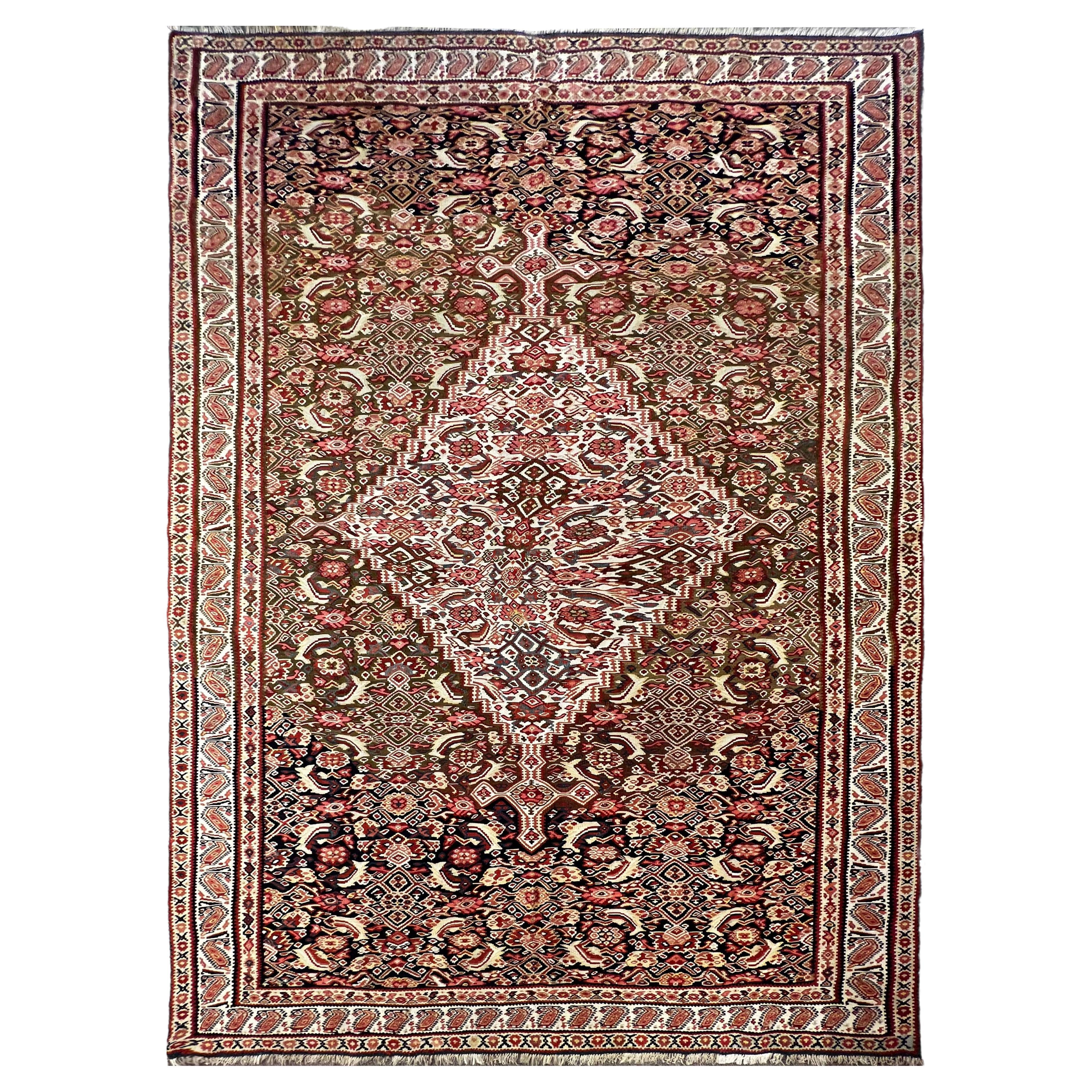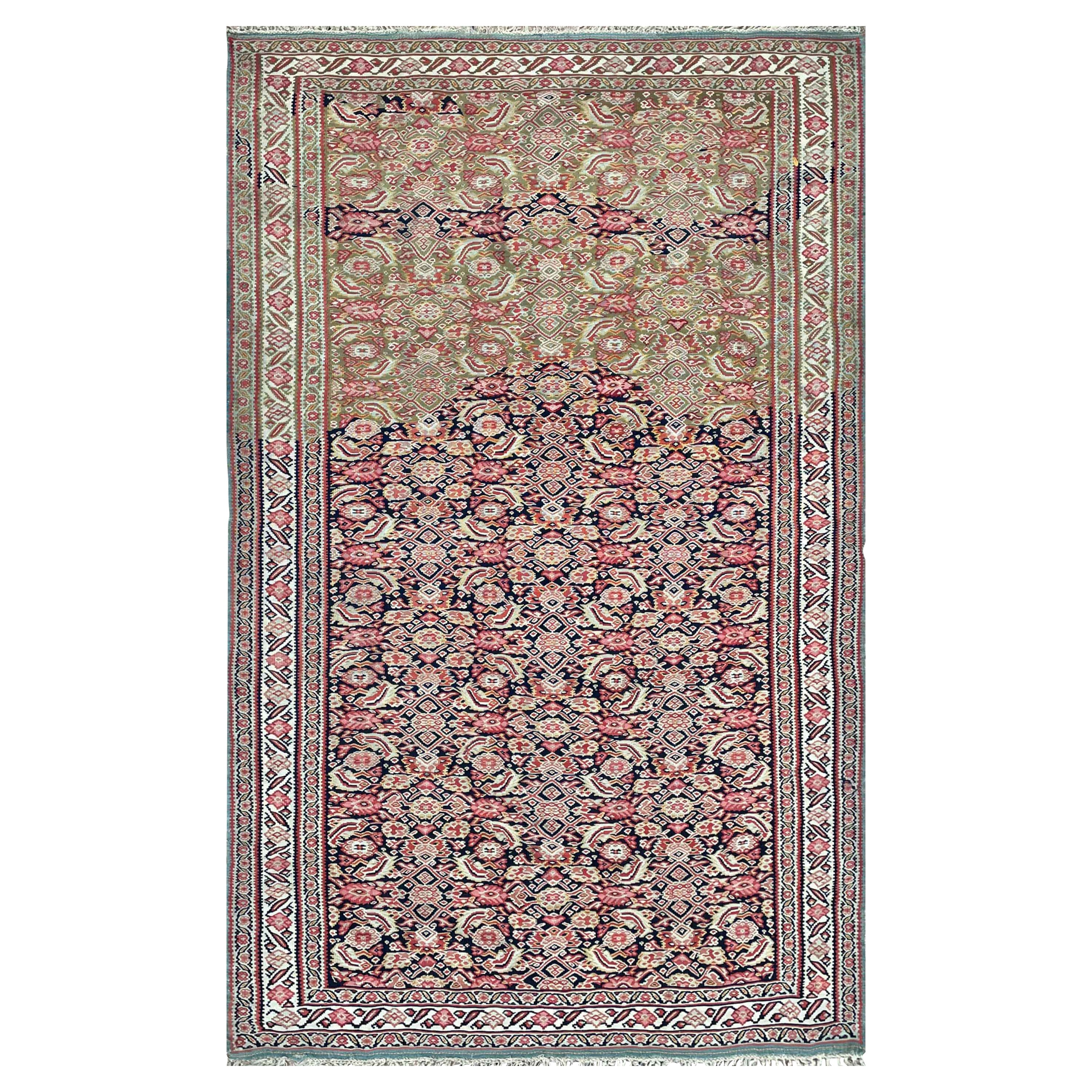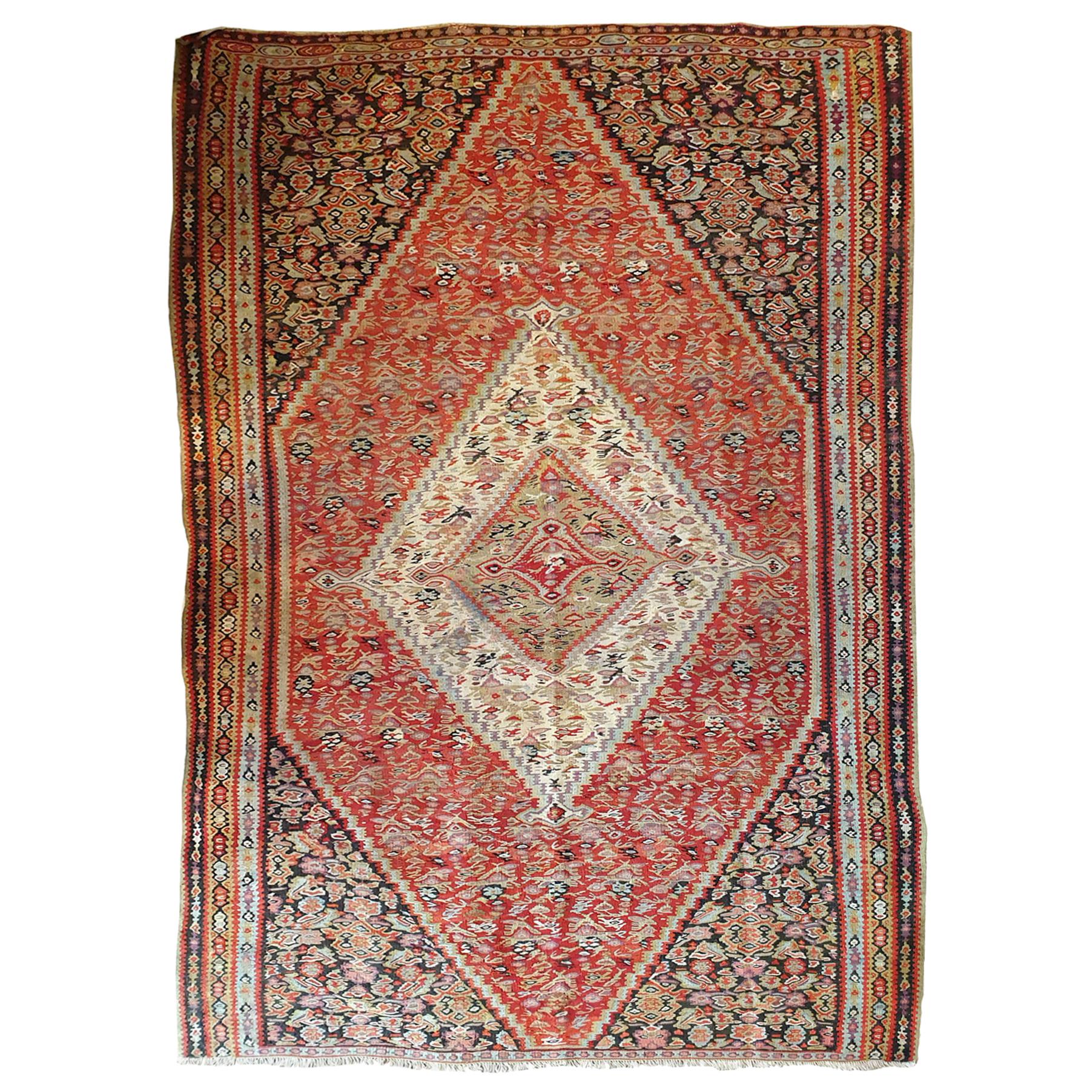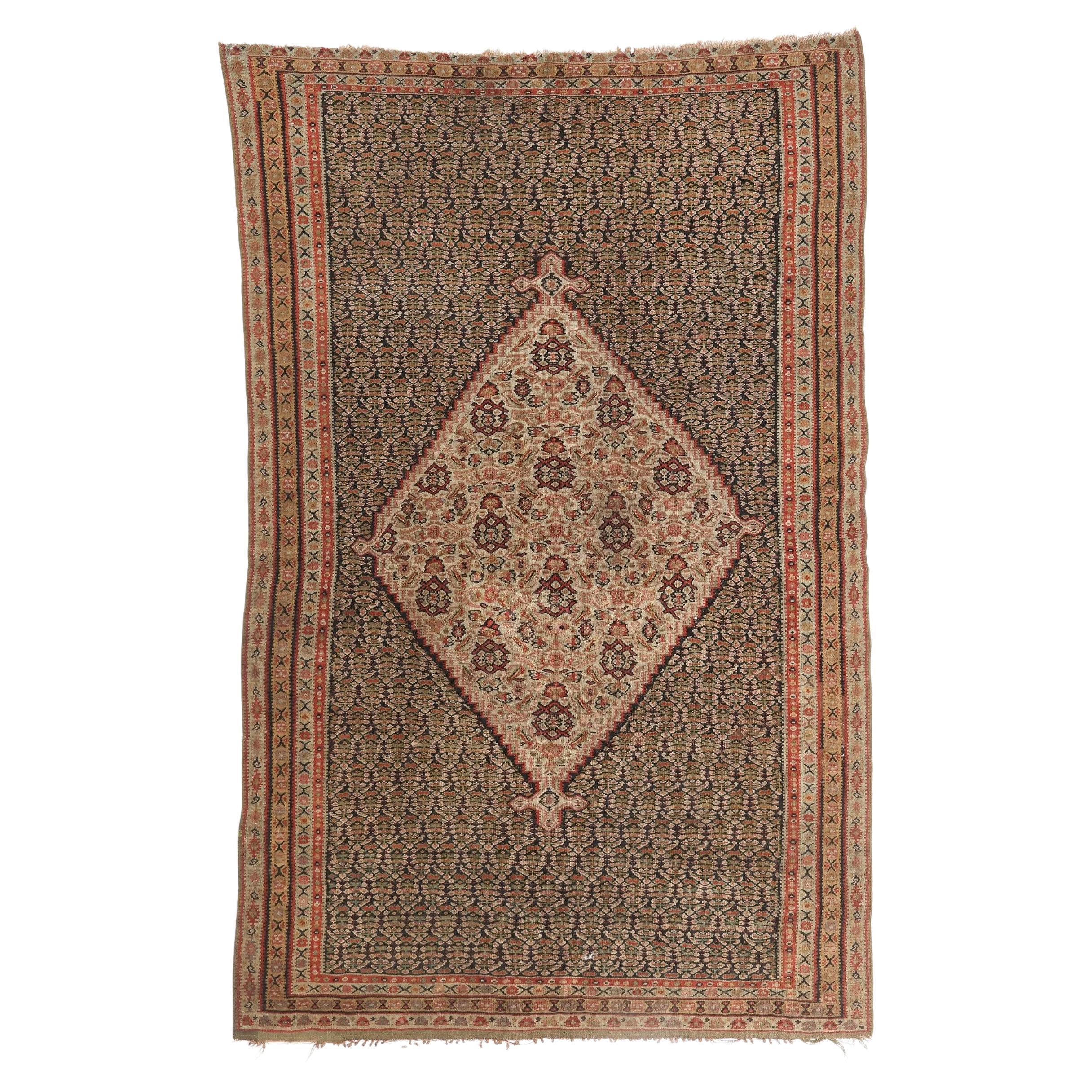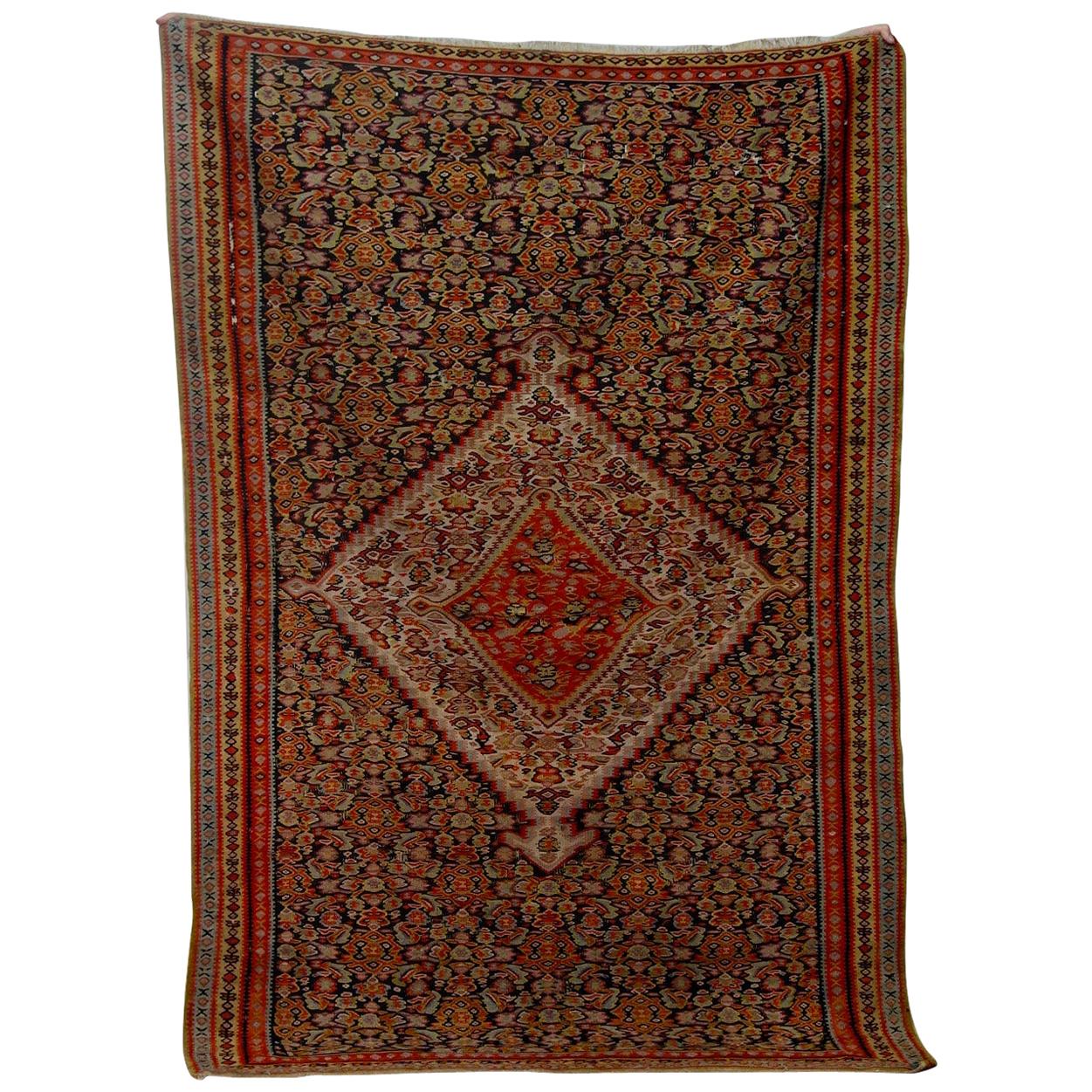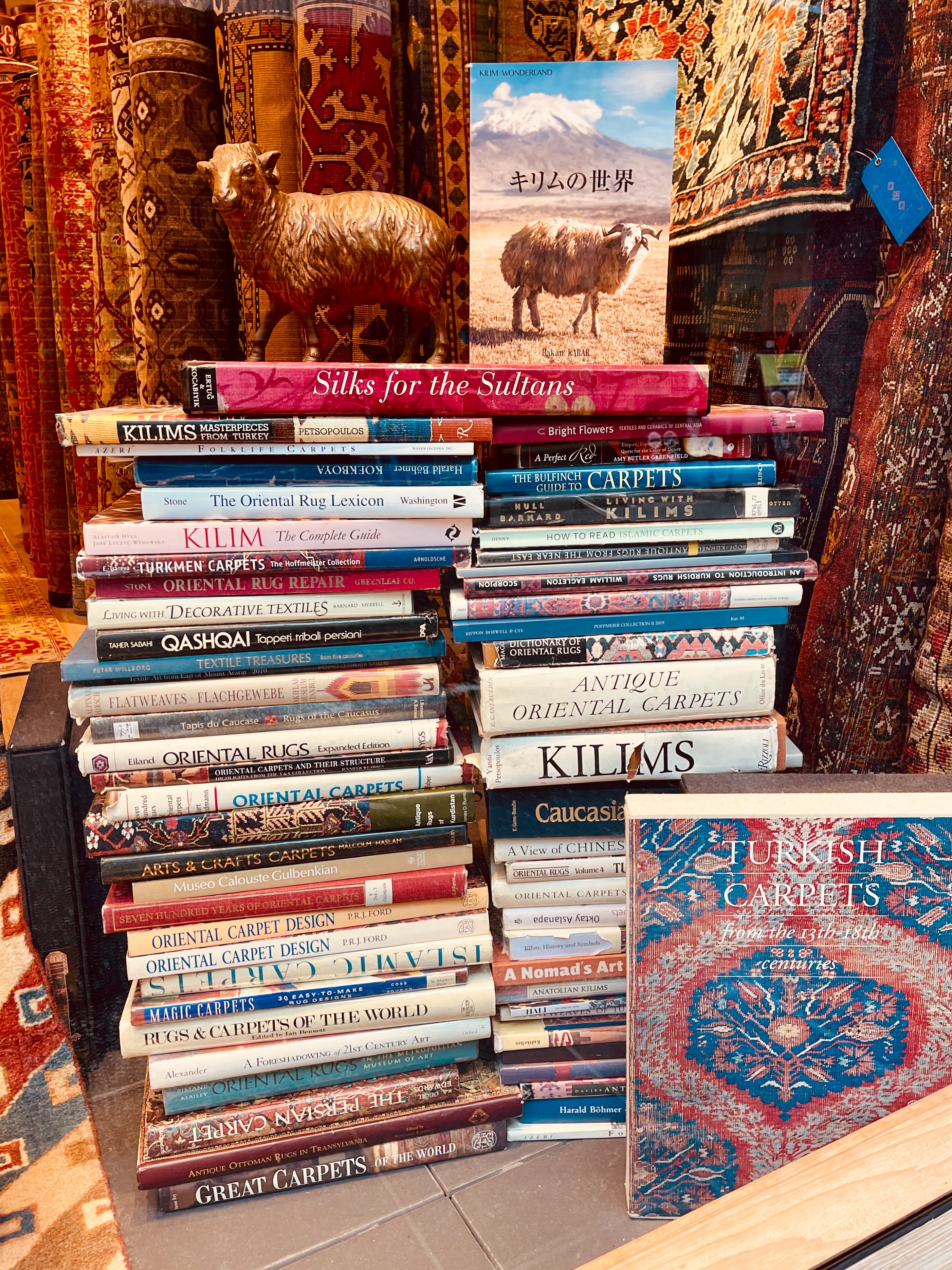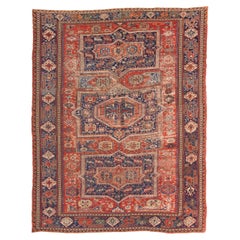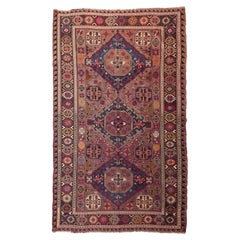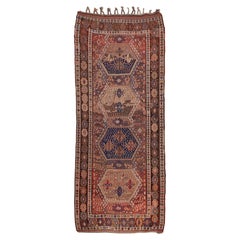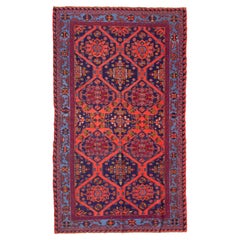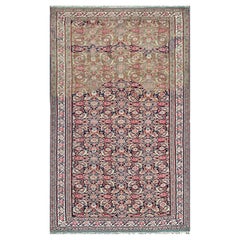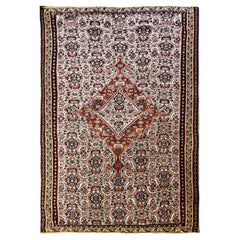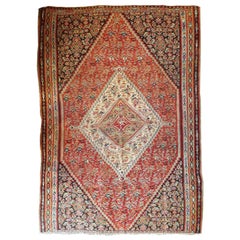Items Similar to Antique Senneh Kilim Senna Rug Wool Caucasia Persian Kurdish Carpet
Video Loading
Want more images or videos?
Request additional images or videos from the seller
1 of 8
Antique Senneh Kilim Senna Rug Wool Caucasia Persian Kurdish Carpet
$6,800
£5,224.19
€6,002.53
CA$9,565.04
A$10,745.90
CHF 5,614.75
MX$131,158.69
NOK 71,290.89
SEK 67,105.36
DKK 44,793.13
About the Item
This is a Northwestern Persian Antique Kurdish Kilim from the Senneh ( Senna, Sanandaj) region with wool threads and a rare, beautiful color composition.
This highly collectible antique kilim has wonderful special colors and textures that are typical of an old kilim in good condition. It is a piece that allows you to feel the beauty of Kilim-like colors and the texture of the old in the best condition.
Senneh carpet differs significantly from that originating in any other part of Kurdistan, and, indeed, even the surrounding villages produce the typical crude Kurdish tribal weaves. The rugs of Senneh have a peculiar fascination. The best examples possess a refinement of texture, originality, and a naïveté in color and design, which are delightful and unsurpassed by any other Persian weave. They are also unique in style and unmistakable: none of the rugs of Persia remotely resemble them. The weavers of this remote little Kurdish town are among the few in Persia who have preserved a style and dignity of their own. For 200 years, they have continued to weave in their way, undisturbed by the whims and fashions of the West.
Throughout the nineteenth century, fine carpets and textiles continued to be woven in Senna for the aristocracy and the rich of Persia; they were also exported to Europe and North America. In the nineteenth century, the Senna designers generally employed a Persian-inspired curvilinear motif that emulated Safavid medallion book cover designs and the popular nineteenth-century Boteh designs, or they used the traditional Kurdish Masi Awita and Mina Khani designs.
- Dimensions:Width: 45.67 in (116 cm)Length: 75.6 in (192 cm)
- Style:Kilim (In the Style Of)
- Materials and Techniques:
- Place of Origin:
- Period:
- Date of Manufacture:circa 1920s
- Condition:Repaired: Minor repairs, with antique natural dyed wool threads by our repair specialists. Wear consistent with age and use. Minor fading.
- Seller Location:Tokyo, JP
- Reference Number:1stDibs: LU8206241486842
ARARAT RUGS
We know and believe that the geography we come from, our past, and our lifestyle are the most important bond between us to carry the oriental carpet art and culture to the next generations along with our core values in our ongoing growth journey.
We are aware that the way to achieve this goal and carry this priceless art and culture to the future depends on a lot of work with all our people every day while adhering to our core values.
For us, art is meaningful in the sense that it brings together various cultures around the world. It is an honor for us that oriental carpet art and culture have been instrumental in this for centuries and that we are a part of this business.
We are tirelessly keeping an eye on auction house information around the world about carpets. New York's Metropolitan, London's Victoria & Albert Museums, and other famous art museums, as well as small specialized museums that house private collections, and books about oriental carpets to collect information on outstanding carpet designs and patterns from around the world. It's our Self-improving and Self-developing culture.
As Turkish Culture of Hospitality, the Kurdish Culture of Generosity, and as Japanese Culture of Business Punctuality; are the most important values that this multicultural background has taught and bequeathed to us. It is essential and valuable for us that you feel this feeling not only by looking at our oriental carpets but from the moment you contact us.
About the Seller
5.0
Platinum Seller
Premium sellers with a 4.7+ rating and 24-hour response times
Established in 1970
1stDibs seller since 2023
55 sales on 1stDibs
Typical response time: 8 hours
- ShippingRetrieving quote...Shipping from: Tokyo, Japan
- Return Policy
Authenticity Guarantee
In the unlikely event there’s an issue with an item’s authenticity, contact us within 1 year for a full refund. DetailsMoney-Back Guarantee
If your item is not as described, is damaged in transit, or does not arrive, contact us within 7 days for a full refund. Details24-Hour Cancellation
You have a 24-hour grace period in which to reconsider your purchase, with no questions asked.Vetted Professional Sellers
Our world-class sellers must adhere to strict standards for service and quality, maintaining the integrity of our listings.Price-Match Guarantee
If you find that a seller listed the same item for a lower price elsewhere, we’ll match it.Trusted Global Delivery
Our best-in-class carrier network provides specialized shipping options worldwide, including custom delivery.More From This Seller
View AllAntique Caucasus Soumak Kilim Sumac Rug, Caucasian Sumak Natural Carpet
Located in Tokyo, JP
This is an Antique Soumak ( Sumak, Sumac ) Kilim from the Caucasus region with a rare and beautiful color composition.
Of the four countries that make up the Caucasus, Azerbaijan produces the most kilims, and the land has a long history of weaving. The nomadic tribes wove kilims and carpets as well as a wide range of storage bags and sacks, such as saffrash, khurgin and chula, and donkey and horse trappings. Smaller bags for salt, utensils, and other items are also common. Not only are the Azerbaijani weavers prolific, but they also employ many techniques at the loom. These include slitweave- known locally by the word Kilim, warp-faced patterning (jajim), supplementary weft (zili), weft wrapping (popularly known as soumak), and extra weft wrapping (verneh). Furthermore, flatweaves are defined by regional names such as palas and shadda, so it is possible to ascribe a variety of weaving names to particular provenances as follows: soumaks are made in Kuba, palas, and kilims in Hajikabul, zili in Khizy, verneh and zili in Kazakh, shadda, verneh and zili in Barda, jajim in Agjabedi, and palas and kilims in Jabrail.
Soumak weave is a technique in which weft threads are added to a plain weave fabric, and one or two warp threads are wound from the front to the back. The resulting Kilim is denser and firmer, giving it a unique feel and look. This technique is commonly used in the Caucasus region.
Soumak kilims have a very beautiful contrast between orange that shines like the sun, deep purple-tinged indigo, and astringent dark red. You can also see the unevenly dyed abrage in this Soumak, which is like a magic carpet with an oriental atmosphere. Features of the Caucasian Kilim, such as the unique cosmic geometric floral pattern, are also found in this Soumak which has a bright look, but it also has a faded and textured feel, so it can be used in a good old atmosphere.
The woven fabric is particularly solid, so it is recommended for use in a solid living room or under a dining table without moving or twisting. A nice Kilim under a long wooden dining table.
Category
Antique Late 19th Century Caucasian Kilim Caucasian Rugs
Materials
Wool, Natural Fiber
Antique Caucasus Soumak Kilim Sumac Rug, Caucasian Natural Carpet
Located in Tokyo, JP
This is a large Antique Soumak ( Sumak, Sumac ) Kilim from the Caucasus region with a rare and beautiful color composition.
Of the four countries that make up the Caucasus, Azerbaijan produces the most kilims, and the land has a long history of weaving. The nomadic tribes wove kilims and carpets as well as a wide range of storage bags and sacks, such as saffrash, khurgin and chula, and donkey and horse trappings. Smaller bags for salt, utensils, and other items are also common. Not only are the Azerbaijani weavers prolific, but they also employ many techniques at the loom. These include slitweave- known locally by the word kilim, warp-faced patterning (jajim), supplementary weft (zili), weft wrapping (popularly known as soumak), and extra weft wrapping (verneh). Furthermore, flatweaves are defined by regional names such as palas and shadda, so it is possible to ascribe a variety of weaving names to particular provenances as follows: soumaks are made in Kuba, palas, and kilims in Hajikabul, zili in Khizy, verneh and zili in Kazakh, shadda, verneh and zili in Barda, jajim in Agjabedi, and palas and kilims in Jabrail.
Soumak weave is a technique in which new weft threads are added to a plain weave fabric, and one or two warp threads are wound from the front to the back. The resulting kilim is denser and firmer, giving it a unique feel and look. This technique is commonly used in the Caucasus region.
Soumak Kilims have a very beautiful contrast between orange that shines like the sun, deep purple-tinged indigo, and astringent dark red. You can also see the unevenly dyed abrage in this sumac, which is like a magic carpet with an oriental atmosphere.
Features of the Caucasian kilim, such as the unique cosmic geometric floral pattern, are also found in this Soumak. It has a bright look, but it also has a faded and textured feel, so it can be used in a good old atmosphere. The woven fabric is particularly solid, so it is recommended for use in a solid living room or under a dining table without moving or twisting. A nice kilim under a long wooden dining table.
Category
Early 20th Century Caucasian Kilim Caucasian Rugs
Materials
Wool, Natural Fiber
Antique Erzurum Kilim Rug Old Eastern Anatolian Turkish Natural Carpet
Located in Tokyo, JP
This is an Eastern Anatolian Antique Kilim from the Erzurum region with a rare and beautiful color composition.
Erzurum was once a key frontier town, used to defend Anatolia against...
Category
Early 20th Century Turkish Kilim Turkish Rugs
Materials
Natural Fiber, Wool
Old Caucasus Soumak Sumac Kilim Rug, Caucasian Natural Sumak Carpet
Located in Tokyo, JP
This is an old Soumak ( Sumak, Sumac ) Kilim from the Caucasus region with a rare and beautiful color composition.
Of the four countries that make up the Caucasus, Azerbaijan produces the most kilims, and the land has a long history of weaving. The nomadic tribes wove kilims and carpets as well as a wide range of storage bags and sacks, such as saffrash, khurgin and chula, and donkey and horse trappings. Smaller bags for salt, utensils, and other items are also common. Not only are the Azerbaijani weavers prolific, but they also employ many techniques at the loom. These include slitweave- known locally by the word kilim, warp-faced patterning (jajim), supplementary weft (zili), weft wrapping (popularly known as soumak), and extra weft wrapping (verneh). Furthermore, flatweaves are defined by regional names such as palas and shadda, so it is possible to ascribe a variety of weaving names to particular provenances as follows: soumaks are made in Kuba, palas, and kilims in Hajikabul, zili in Khizy, verneh and zili in Kazakh, shadda, verneh and zili in Barda, jajim in Agjabedi, and palas and kilims in Jabrail.
Soumak weave is a technique in which weft threads are added to a plain weave fabric, and one or two warp threads are wound from the front to the back. The resulting kilim is denser and firmer, giving it a unique feel and look. This technique is commonly used in the Caucasus region.
Soumak has a very beautiful contrast between orange that shines like the sun, deep purple-tinged indigo, and astringent dark red. You can also see the unevenly dyed abrage in this Soumak, which is like a magic carpet with an oriental atmosphere. Features of the Caucasian kilim, such as the unique cosmic geometric floral pattern, are also found in this Soumak which has a bright look, but it also has a faded and textured feel, so it can be used in a good old atmosphere.
The woven fabric is particularly solid, so it is recommended for use in a solid living room or under a dining table without moving or twisting. A nice kilim under a long wooden dining table.
Category
Mid-20th Century Caucasian Kilim Caucasian Rugs
Materials
Natural Fiber, Wool
Antique Kurdish Rug Eastern Anatolian Turkish Carpet Handwoven Natural Dye
Located in Tokyo, JP
This is an Antique Kurdish Rug from the Eastern Anatolia region with a rare and beautiful color composition.
Anatolian Kurdish rugs are handwoven rugs that originate from the Anatol...
Category
Early 20th Century Turkish Oushak Turkish Rugs
Materials
Wool, Natural Fiber
Antique Yahyali Kayseri Kilim Central Anatolia Old Rug Turkish Wool Carpet
Located in Tokyo, JP
This is an antique Central Anatolian Kilim from the Yahyali region in Kayseri with a rare and beautiful color composition.
The earliest recorded occupation of Kayseri dates back to ...
Category
Mid-20th Century Turkish Kilim Turkish Rugs
Materials
Wool, Natural Fiber
You May Also Like
206 - Kilim 19th Century Senneh
Located in Paris, FR
206 - kilim 19th century senneh.
Category
Antique 1850s Asian Kilim Central Asian Rugs
Materials
Wool
Antique Persian Senneh Kilim, flat weave
Located in Evanston, IL
Enhancing the description of the Antique Persian Senneh Kilim Rug:
Adorning your space with an exquisite piece of textile art, we present an Antique Persian Senneh Kilim Rug from the...
Category
Early 20th Century Persian Kilim Persian Rugs
Materials
Wool
$1,519 Sale Price
38% Off
1033 - Very Nice Old Kilim Senneh
Located in Paris, FR
1033 - nice Kilim from the end of the 19th century with beautiful fine central medallion designs, and beautiful colors with pink, orange, yellow, green and dark brown, entirely and f...
Category
Antique 1880s Central Asian Kilim Central Asian Rugs
Materials
Wool
660 - Antique Fine Senneh Kilim, 19th Century
Located in Paris, FR
660 - beautiful late 19th century Kilim Senneh with decorative design and pretty natural colors with blue, green, gray, red, pink, completely handwoven with wool on cotton foundation.
Category
Antique 1880s South Asian Kilim Central Asian Rugs
Materials
Wool
Senneh Kilim Late 19th C. Wool Rug
Located in Brooklyn, NY
This Senneh Kilim Wool Rug originated from Persia in the late 19th century. Features a central medallion against a delicate paisley, or “boteh” motif.
Category
Antique Late 19th Century Persian Kilim Persian Rugs
Materials
Wool
Fine Early 20th Century Senneh Kilim Rug
Located in Basingstoke, Hampshire
A fine Senneh kilim, dating from the late 19th-early 20th century. A very striking example demonstrating a large central medallion surrounded by well drawn Heratti design displaying ...
Category
Antique Late 19th Century Asian Kilim More Carpets
Materials
Wool
More Ways To Browse
1970s Oak Table
Black Empire Table
Black Tripod Table
Bronze Frame Chair
Carved Library Table
Designer Ashtray
Fox Head
German 1930s Ceramics
German Wooden Chairs
Glass Goblet Set
Luxury Entry Console Table
Mahogany Tall Tables
Marble Top Mahogany Dining Table
One Of A Kind Dining Chair
Outdoor Teak Tables
Pink Rose Porcelain
Punch Glasses
Pyramid Base Table
